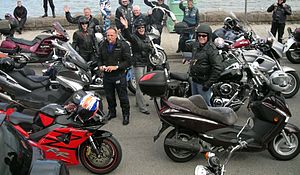
Back Tipus de motocicletes Catalan Typy motocyklů Czech انواع موتورسیکلت Persian Types de motos French オートバイの種類 Japanese Lista de tipos de motocicletas Portuguese Типы мотоциклов Russian Motosiklet türleri Turkish 摩托車類型 Chinese

In the market, there is a wide variety of types of motorcycles, each with unique characteristics and features. Models vary according to the specific needs of each user, such as standard, cruiser, touring, sports, off-road, dual-purpose, scooters, etc.[1][2][3][4][5] Often, some types like sport touring are considered as an additional category or integrated with touring.[6][7]
There is no universal system for classifying all types of motorcycles.[8] However, some authors argue that there are generally six categories recognized by most motorcycle manufacturers and organizations,[6] making clear distinctions between these six main types and other motorcycles. For example, scooters, mopeds, underbones, minibikes, pocket bikes, electric bikes, and three-wheeled motorcycles are often excluded from the main categories within these classifications, but other classification schemes may also include these types of motorcycles.[9]
Nevertheless, there are strict classification systems enforced by competitive motorcycle sport sanctioning bodies, or legal definitions of a motorcycle established by certain legal jurisdictions for motorcycle registration, emissions, road traffic safety rules or motorcyclist licensing. There are also informal classifications or nicknames used by manufacturers, riders, and the motorcycling media. Some experts do not recognize sub-types, like naked bike, that "purport to be classified" outside the usual classes, because they fit within one of the main types and are recognizable only by cosmetic changes.[10]
Street motorcycles are motorcycles designed for being ridden on paved roads. They have smooth tires with tread patterns and engines generally in the 125 cc (7.6 cu in) and over range. Typically, street motorcycles are capable of speeds up to 100 mph (160 km/h), and many of speeds in excess of 125 mph (201 km/h). Street motorcycles powered by electric motors are becoming more common, with firms like Harley-Davidson entering the market.
- ^ Scooters are a type of motorcycle:
- Oxford Advanced Learner's Dictionary. Oxford, UK: Oxford University Press. ISBN 978-0-19-860564-5.
motor scooter n a light motorcycle, usually with small wheels and a curved metal cover at the front to protect the rider's legs
- Collins English Dictionary and Thesaurus (3rd ed.). Glasgow: Harper Collins Publications. 2004. p. 776. ISBN 0-00-718139-6.
motor scooter n a light motorcycle with small wheels and an enclosed engine. Often shortened to scooter
- Chambers Concise Dictionary. Edinburgh: Chambers Harrup Publishers. 2004. p. 1084. ISBN 0-550-10072-5.
2. (in full motor scooter) a small-wheeled motorcycle with a protective front shield curving back to form a support for the feet
- "Types of Motorcycles:A beginner's guide". Honda. Retrieved 2024-05-01.
- "Motorcycle Categories: Different Types of Motorbikes Explained". United News of Bangladesh. 2021-08-09.
- "A complete guide to all motorbike types". Bennetts. Retrieved 2024-05-01.
- Oxford Advanced Learner's Dictionary. Oxford, UK: Oxford University Press. ISBN 978-0-19-860564-5.
- ^ Cite error: The named reference
Kresnak2008was invoked but never defined (see the help page). - ^ Cite error: The named reference
Domino2009was invoked but never defined (see the help page). - ^ Cite error: The named reference
Holmstrom2001was invoked but never defined (see the help page). - ^ McCraw, Jim (July 2005), "About That Bike…", Popular Mechanics, vol. 182, no. 7, Hearst Magazines, pp. 68–70, ISSN 0032-4558, retrieved 2010-06-04
- ^ a b Maher, Kevin; Greisler, Ben (1998), Chilton's Motorcycle Handbook, Haynes North America, pp. 2.2–2.18, ISBN 0-8019-9099-8
- ^ "Sports [sic] Tourers". Suzuki GSX1100F, Honda CBR1000F, Yamaha GTS1000. Motorcycle Sport, June 1995, pp.284-288. Accessed 28 May 2022
- ^ The MAIDS report, using the OECD Road Transport Research Programme methodology, uses the following nine classifications for motorcycles, mopeds, and scooters, providing one illustration of each:
- Conventional street example: Triumph Bonneville T100
- Sport example: Triumph Daytona 955i
- Cruiser example: Suzuki Marauder
- Chopper example: a Harley-Davidson chopper in David Mann red
- Touring example: Honda Gold Wing GL1800
- Scooter example: Vespa Granturismo 200
- Step-through example: a moped
- Sport Touring example: Ducati ST4s
- Enduro example: KTM 950 Adventure S
- International Coordinating Committee of the Expert Group for Motorcycle Accident Investigations (2001), Motorcycles: Common International Methodology for On-Scene, In-Depth Accident Investigation, Paris: Road Transport Research Programme; of the Directorate for Science Technology and Industry; of the Organization for Economic Cooperation and Development, OECD/DSTI/RTR/RS9/ICC
- MAIDS (Motorcycle Accidents In Depth Study) Final Report 2.0, ACEM, the European Association of Motorcycle Manufacturers, April 2009, pp. 15–20
- ^ Bennett, Jim (1995), The Complete Motorcycle Book: A Consumer's Guide, Facts on File, pp. 15–16, 19–25, ISBN 0-8160-2899-0
- ^ Broughton, Paul; Walker, Linda (May 6, 2009), Motorcycling and Leisure; Understanding the Recreational PTW Rider, Ashgate Publishing, Ltd., p. 7, ISBN 9780754675013, retrieved September 14, 2013